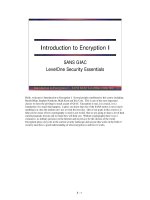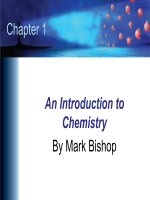INTRODUCTION basic chemistry i
Bạn đang xem bản rút gọn của tài liệu. Xem và tải ngay bản đầy đủ của tài liệu tại đây (1.04 MB, 39 trang )
INTRODUCTION
Basic Chemistry I
Gasal 2011/2012
Chemistry
?
• The science of composition, structure,
properties, and reaction of matter.
• The science that deals with the materials of the
universe and the changes that these materials
undergo.
• Not only concern with the composition and
changes in composition of matter, but also with
the energy & energy changes associated with
matter.
• Why do we have to study chemistry?
• What’s the relevance with food science?
The branches of chemistry
1.
2.
Inorganic chemistry
It deals with all elements but carbon, as well as
with some carbon compounds derived mainly
from mineral sources.
Organic chemistry
Concern with compounds containing the element
carbon derived from living organisms.
Why does soda fizz when
you open the bottle?
How to make candy?
How pop corn pops?
• Popcorn kernels contain oil and water with starch, surrounded
by a hard and strong outer coating.
• When popcorn is heated, the water inside the kernel tries to
expand into steam, but it cannot escape through the seed
coat (the popcorn hull).
• The hot oil and steam gelatinizes the starch inside the
popcorn kernel, making it softer and more pliable.
• When the popcorn reaches a temperature of 180 °C (356 °F)
the pressure inside the kernel is around 135 psi (930 kPa),
which is sufficient pressure to rupture the popcorn hull,
essentially turning the kernel inside-out. The pressure inside
the kernel is released very quickly, expanding the proteins
and starch inside the popcorn kernel into a foam, which cools
and sets into the familiar popcorn puff.
Liquid Nitrogen Ice Cream
• When we make liquid
nitrogen ice cream the
nitrogen boils off
harmlessly into the air
rather than becoming an
ingredient in the recipe.
• Nitrogen is used to cool
ice cream so that you
don't have to wait around
for a freezer or ice cream
maker.
Classification and
Properties of Matter
Matter:
- anything that has mass & occupies space.
- It exists in 3 physical states: solid, liquid & gas.
Substance:
A particular kind of matter
with a definite, fixed
composition.
Element:
• A substance that cannot be broken down into other
substances by chemical methods.
• Examples of elements are iron, aluminum, oxygen, and
hydrogen.
• Elements are defined by the number of protons they
possess.
Compound:
• A substance compose of a given combination of
elements that can be broken down into those elements
by chemical methods. Ex: water
Mixture:
• Something that has variable composition.
• Mixtures can be separated into pure substances:
elements and/or compounds.
• Mixtures can be classified as either homogeneous (ex:
salt solution) or heterogeneous.
Matter
Pure substances
(homogenous composition)
Elements
Compounds
Mixture of two or
more substances
Solutions
(homogenous
composition-one
phase)
Heterogenous
Mixture (two or
More phases)
Atom
the fundamental unit of a chemical substance
(Greek, atomos: uncut-able)
An atom is the smallest possible particle of an
element; extremely small
Molecule
A combination of two or more atoms held
together in a specific shape by attractive forces
Most chemistry deals with the behavior of
molecules
Atomic Theory
And Structure
The development of atomic theory
• Democritus (470-380 BC)
atomos: indivisible; the smallest bit of matter that cannot be
divided further
• Aristotle (384-322 BC) & others
no matter how small the portion of matter, it remains uniform
in composition.
• John Dalton (1766-1844)
• J. Jakob Berzelius (1779-1848)
Substances always combine in fixed proportions
• J.J. Thomson (1890s)
The atoms of any element can be made to emit
tiny negative particles, called electrons.
• Ernest Rutherford
Nuclear atom—an atom with a dense center of
positive charge (the nucleus) around which tiny
electrons moved in a space that was otherwise
empty.
Atomic theory
• The essential features of atoms:
- all matter is composed of tiny particles called atoms
- all atoms of a given element have identical chemical
properties
- atoms of different elements have distinct properties
- atoms form chemical compounds by combining in
whole-number ratios. All samples of a pure compound
have the same combination of atoms
- in chemical reactions, atoms change the ways they
are combined, but they are neither created or
destroyed
- Water always contains 1.0 g of hydrogen for every
8.0 g of oxygen the composition doesn’t
change although the amount does.
2 H2 + O2 2 H2O
- Hydrogen & Oxygen as the reactants or starting
materials
- Water is the reaction product
- Balanced chemical equation
(g)
(g)
(l)
• Atoms combine (in whole-number ratios) to make
compounds
• Atoms are constantly in motion
- Brownian motion (1828, Robert Brown)
- Diffusion of one liquid into another
• Dynamic equilibrium
- A system at equilibrium shows no change in its
observable properties
A dynamic system contains objects
that move continuously









